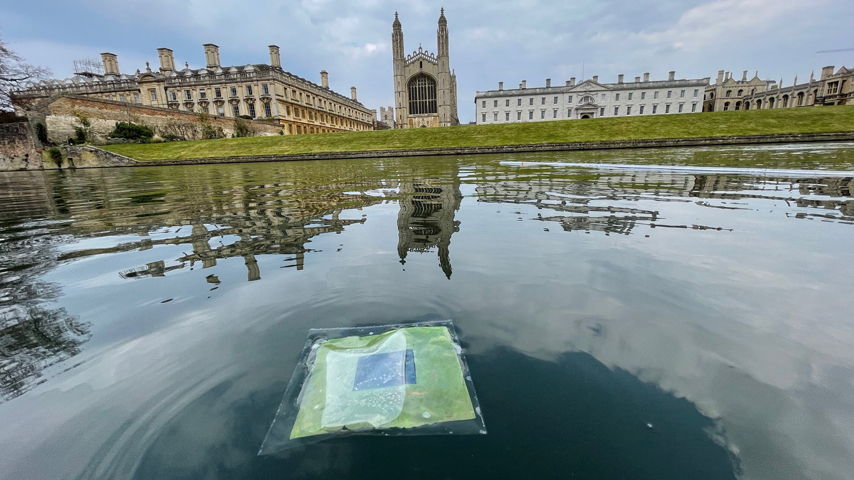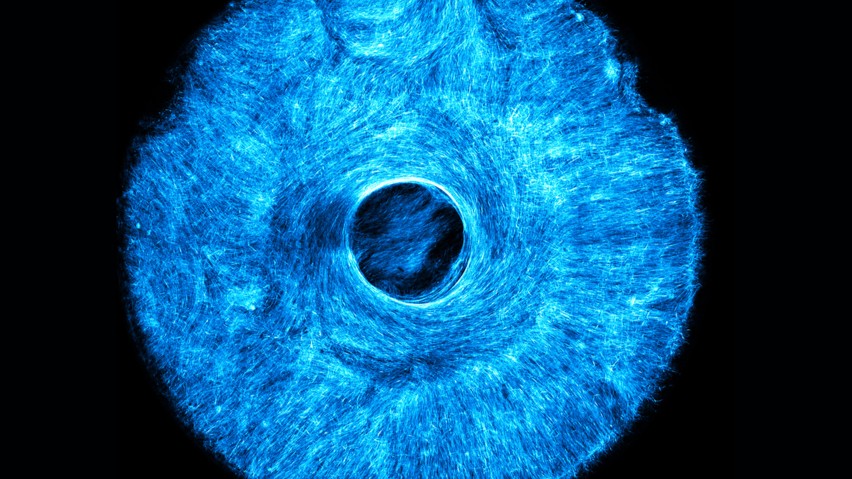Floating Device Cleans Water, Makes Hydrogen
Floating Device Cleans Water, Makes Hydrogen


Using visible, infrared, and ultraviolet light, a system could provide drinking water and fuel for rural locations.
Researchers at the University of Cambridge in England believe they have developed a two-for-one solution that tackles a pair of sustainability challenges. While working on a way to generate hydrogen fuel cheaply enough for use in rural areas of the developing world, the research team found that its solution also produced clean water from saline or polluted sources.
One of the major drawbacks to so-called artificial leaf technology, which uses a photosynthesis-like process to obtain clean hydrogen, has been the requirement to start with clean, uncontaminated water. Even briny water can foul the process. That has presented a challenge to deploying the technology since purifying the water adds energy and economic penalties.
A research group led by Cambridge Professor Erwin Reisner looked for a cheap and sustainable method for providing clean, fresh water to an artificial leaf.
“This work originated in November 2019, sparked by the question of whether hydrogen could be produced from seawater, given the challenges associated with ultra-pure water scarcity for conventional hydrogen production,” said Chanon Pornrungroj, a member of the research team who now is a lecturer in chemical engineering at Chulalongkorn University in Bangkok.
“The team, inspired by this challenge, conceptualized a floating device combining two types of solar energy materials: a sheet designed for producing hydrogen through photocatalysis and a solar vapor generator for generating clean water,” Pornrungroj said.
The team integrated both materials “to create a hybrid photocatalyst-photothermal sheet, which is a self-contained floating device capable of efficiently harnessing the entire solar spectrum,” Pornrungroj said. The lower layer acts as a solar vapor generator, using visible and infrared light to produce water vapor.
“Meanwhile, the upper layer is a photocatalyst that absorbs ultraviolet light, leading to the generation of hydrogen and oxygen from the water vapor produced by the solar vapor generator. Any excess clean water vapor is condensed and gathered as distilled pure water,” he said.
Utilizing the full spectrum of light enables the Cambridge device to be more efficient than previous solar water-splitting technologies.
“One big issue with photocatalysts is that they utilize only a small portion of the solar spectrum—UV and some visible light,” Mohamad Annuar said. “Having the solar vapor generator allows the remaining light to be utilized.”
The Cambridge team sees limits to that approach.
“The straw or other filtration produces a safe-enough water to drink, but there are plenty of contaminants left,” such as bacteria and viruses, Pornrungroj said. And hydrogen can’t be made from water with those pollutants.
Learn more about development engineering: Engineering for Change
Straws and the like also don’t allow for a way to collect and store purified water, Mohamad Annuar said.
“More generally, water purification is a multistep process involving coagulation, flocculation, sedimentation, and filtration,” he said. “Depending on the quality of the water source, water purification can be quite energy intensive. The current device allows us to skip a lot of these steps by using a solar vapor generator. It uses just sunlight to boost the evaporation rate of water.”
More great ideas: ASME Innovation Showcase
Water filters also don’t generate hydrogen fuel. The gas remains in the headspace of the Cambridge device’s reactor, from which it can be collected and put into storage. Meanwhile, the remaining water vapor condenses on a tilted window to form droplets that flow down into another compartment, separated from contaminated water.
There’s more work to be done. The team lists such challenges as enhancing efficiency and scalability of the photocatalysts, working out storage and distribution infrastructure for the hydrogen fuel, and reducing the cost of the water purification materials.
But the researchers see many potential uses. In areas of conflict or natural disaster, the device’s “decentralized and off-grid nature could prove invaluable in providing clean water and fuel,” Pornrungroj said.
Eydie Cubarubbia is a technology writer in New York City.
One of the major drawbacks to so-called artificial leaf technology, which uses a photosynthesis-like process to obtain clean hydrogen, has been the requirement to start with clean, uncontaminated water. Even briny water can foul the process. That has presented a challenge to deploying the technology since purifying the water adds energy and economic penalties.
A research group led by Cambridge Professor Erwin Reisner looked for a cheap and sustainable method for providing clean, fresh water to an artificial leaf.
“This work originated in November 2019, sparked by the question of whether hydrogen could be produced from seawater, given the challenges associated with ultra-pure water scarcity for conventional hydrogen production,” said Chanon Pornrungroj, a member of the research team who now is a lecturer in chemical engineering at Chulalongkorn University in Bangkok.
“The team, inspired by this challenge, conceptualized a floating device combining two types of solar energy materials: a sheet designed for producing hydrogen through photocatalysis and a solar vapor generator for generating clean water,” Pornrungroj said.
Full spectrum
Harnessing solar power to heat and evaporate water is an old technology, and researchers have used photocatalysts for splitting water into hydrogen and oxygen for some time. “The individual components of the device were already established,” said Cambridge doctoral student Ariffin Mohamad Annuar. “The novelty of this work was in integrating these components together so that they could work synergistically.”The team integrated both materials “to create a hybrid photocatalyst-photothermal sheet, which is a self-contained floating device capable of efficiently harnessing the entire solar spectrum,” Pornrungroj said. The lower layer acts as a solar vapor generator, using visible and infrared light to produce water vapor.
“Meanwhile, the upper layer is a photocatalyst that absorbs ultraviolet light, leading to the generation of hydrogen and oxygen from the water vapor produced by the solar vapor generator. Any excess clean water vapor is condensed and gathered as distilled pure water,” he said.
Utilizing the full spectrum of light enables the Cambridge device to be more efficient than previous solar water-splitting technologies.
“One big issue with photocatalysts is that they utilize only a small portion of the solar spectrum—UV and some visible light,” Mohamad Annuar said. “Having the solar vapor generator allows the remaining light to be utilized.”
Two for one
Water purification devices can meet an important need in the developing world, where clean water can be difficult to come by. One simple device that received a lot of attention a few years ago was a drinking straw that enabled a person to sip directly from a river, stream, lake, or other water body of questionable cleanliness, treating it enough to be potable.The Cambridge team sees limits to that approach.
“The straw or other filtration produces a safe-enough water to drink, but there are plenty of contaminants left,” such as bacteria and viruses, Pornrungroj said. And hydrogen can’t be made from water with those pollutants.
Learn more about development engineering: Engineering for Change
Straws and the like also don’t allow for a way to collect and store purified water, Mohamad Annuar said.
“More generally, water purification is a multistep process involving coagulation, flocculation, sedimentation, and filtration,” he said. “Depending on the quality of the water source, water purification can be quite energy intensive. The current device allows us to skip a lot of these steps by using a solar vapor generator. It uses just sunlight to boost the evaporation rate of water.”
More great ideas: ASME Innovation Showcase
Water filters also don’t generate hydrogen fuel. The gas remains in the headspace of the Cambridge device’s reactor, from which it can be collected and put into storage. Meanwhile, the remaining water vapor condenses on a tilted window to form droplets that flow down into another compartment, separated from contaminated water.
There’s more work to be done. The team lists such challenges as enhancing efficiency and scalability of the photocatalysts, working out storage and distribution infrastructure for the hydrogen fuel, and reducing the cost of the water purification materials.
But the researchers see many potential uses. In areas of conflict or natural disaster, the device’s “decentralized and off-grid nature could prove invaluable in providing clean water and fuel,” Pornrungroj said.
Eydie Cubarubbia is a technology writer in New York City.







